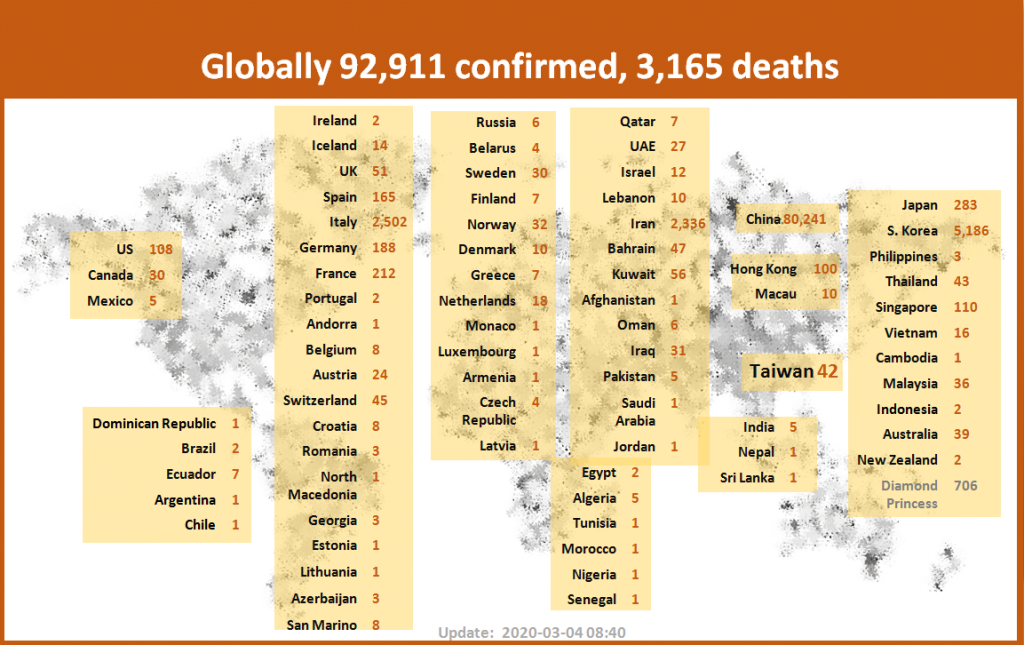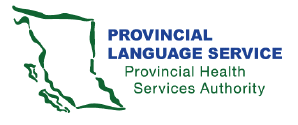Coronaviruses (CoV) are a family of viruses that cause sicknesses like the common cold, as well as more severe diseases, such as Middle East Respiratory Syndrome and Severe Acute Respiratory Syndrome. A novel coronavirus (nCoV) is a new strain – one that hasn’t previously been recognized in humans.
Coronaviruses (CoV) គឺជាអំបូរនៃវីរុសដែលបង្ករឱ្យមានជំងឺដូចជាផ្តាសាយធម្មតាក៏ដូចជាជំងឺធ្ងន់ធ្ងរជាច្រើនទៀត ដូចគ្នានឹងរោគសញ្ញាផ្លូវដង្ហើមមជ្ឈិមបូព៌ានិងរោគសញ្ញាផ្លូវដង្ហើមធ្ងន់ធ្ងរ។ មេរោគប្រលោមលោកថ្មីគឺជាវីរុសថ្មីមួយដែលមិនត្រូវបានគេទទួលស្គាល់នៅក្នុងខ្លួនមនុស្សទេពីមុនមក។
Coronaviruses cause diseases in mammals and birds. A zoonotic virus is one that is transmitted between animals and people. When a virus circulating in animal populations infects people, this is termed a “spillover event”.
ជំងឺ Coronaviruses បង្កជំងឺក្នុងថនិកសត្វនិងបក្សី។ វីរុសហ្សូណូទិកគឺជាវីរុសមួយដែលឆ្លងរវាងសត្វនិងមនុស្ស។ នៅពេលវីរុសដែលរាលដាលនៅក្នុងហ្វូងសត្វ ហើយឆ្លងទៅមនុស្សនេះត្រូវបានគេហៅថា“ព្រឹត្តិការណ៍លេចធ្លាយ” ។
How does CoVID-19 affect the body? តើកូវិដ១៩ ប៉ះពាល់ដល់រាងកាយយ៉ាងដូចម្តេច?
The virus is fitted with protein spikes sticking out of the envelope that forms the surface and houses a core of genetic material. Any virus that enters your body looks for cells with compatible receptors – ones that allow it to invade the cell. Once they find the right cell, they enter and use the cell’s replication machinery to create copies of themselves. It is likely that COVID-19 uses the same receptor as SARS – found in both lungs and small intestines.
វីរុសនេះត្រូវបានបំពាក់ដោយជាតិប្រូតេអ៊ីនដែលស្ថិតជាប់នឹងផ្នែកខាងក្រៅដែលបង្កើតជាផ្ទៃនិងជាស្នូលនៃសារធាតុហ្សែន។ វីរុសណាមួយដែលចូលក្នុងខ្លួនរបស់អ្នក វាស្វែងរកកោសិកាដែលមានឧបករណ៍ទទួលសញ្ញាដែលត្រូវគ្នា – ដែលអនុញ្ញាតឱ្យវាលុកលុយចូលក្នុងកោសិកាបាន។ នៅពេលដែលពួកគេរកឃើញកោសិកាត្រឹមត្រូវ ពួកគេចូលហើយប្រើគ្រឿងម៉ាស៊ីនចម្លងរបស់កោសិកាដើម្បីបង្កើតច្បាប់ចម្លងដោយខ្លួនឯង។ វាទំនងដូចជាកូវិដ-១៩ ប្រើឧបករណ៍ទទួលសញ្ញាដូចគ្នានឹងសារ – រកឃើញទាំងក្នុងសួតនិងពោះវៀនតូច។

It is thought that CoVID-19 shares many similarities with SARS, which has three phases of attack: viral replication, hyper-reactivity of the immune system, and finally pulmonary destruction. Early on in infection, the coronavirus invades two types of cells in the lungs – mucus and cilia cells. Mucus keeps your lungs from drying out and protects them from pathogens. Cilia beat the mucus towards the exterior of your body, clearing debris – including viruses! – out of your lungs. Cilia cells were the preferred hosts of SARS-CoV, and are likely the preferred hosts of the new coronavirus. When these cells die, they slough off into your airways, filling them with debris and fluid. Symptoms include a fever, cough, and breathing difficulties. Many of those infected get pneumonia in both their lungs.
វាត្រូវបានគេគិតថាកូវិត១៩ ចែករំលែកភាពស្រដៀងគ្នាជាច្រើនជាមួយរោគសារដែលមានការវាយប្រហារបីដំណាក់កាលគឺ៖ ការបង្កើតច្បាប់ចម្លងវីរុស ប្រតិកម្មខ្ពស់ទៅលើប្រព័ន្ធភាពស៊ាំ និងទីបំផុតការបំផ្លាញសួត។ នៅពេលមានការឆ្លងមេរោគ វីរុសកូរ៉ូណាបានរាតត្បាតកោសិកាពីរប្រភេទនៅក្នុងសួត – កោសិកាជាតិរំអិលនិងកោសិការោមល្អិតឆ្មាឈ្មោះស៊ីលីយ៉ា។ កោសិកាជាតិរំអិលការពារសួតរបស់អ្នកពីការស្ងួតនិងការពារភ្នាក់ងារជំងឺ។ កោសិការោមល្អិតឆ្មាឬស៊ីលីយ៉ារុញច្រានជាតិទឹករំអិលឆ្ពោះទៅផ្នែកខាងក្រៅនៃរាងកាយរបស់អ្នកដើម្បីសំអាតកំទេចកំទី – រួមទាំងមេរោគចេញពីសួតរបស់អ្នក។ កោសិការរោមល្អិតឆ្មាគឺជាម្ចាស់ផ្ទះដែលមេរោគសារនិងកូវិដចូលចិត្តជាងគេ ហើយទំនងជាម្ចាស់ផ្ទះដែលចូលចិត្តទទួលយកវីរុសថ្មី។ នៅពេលកោសិកាទាំងនេះងាប់ពួកវានឹងរអិលចូលទៅក្នុងផ្លូវដង្ហើមរបស់អ្នកដោយបំពេញវាដោយកំទេចកំទីនិងសារធាតុរាវ។ រោគសញ្ញារួមមានគ្រុនក្តៅ ក្អក និងពិបាកដកដង្ហើម។ ភាគច្រើននៃអ្នកដែលឆ្លងជំងឺនេះមានជំងឺរលាកសួតទាំងពីររបស់ពួកគេ។
Enter the immune system បញ្ចូលប្រព័ន្ធភាពស៊ាំ
Immune cells recognize the virus and flood into the lungs. The lung tissue becomes inflamed. During normal immune function, the inflammatory process is highly regulated and is confined to infected areas. However, sometimes the immune system overreacts, and this results in damage to healthy tissue. More cells die and slough off into the lungs, further clogging them and worsening the pneumonia.
កោសិកាភាពស៊ាំទទួលស្គាល់វីរុសនិងជន់លិចទៅក្នុងសួត។ ជាលិកាសួតក្លាយទៅជារលាក។ ក្នុងអំឡុងពេលមុខងារភាពស៊ាំដំណើរការធម្មតា ការរលាកត្រូវបានគ្រប់គ្រងយ៉ាងខ្លាំងហើយត្រូវបានកំណត់ទៅតំបន់ដែលមានមេរោគឆ្លង។ ទោះជាយ៉ាងណាក៏ដោយ ពេលខ្លះប្រព័ន្ធភាពស៊ាំប្រតិកម្មហួសកំរិតហើយលទ្ធផលនេះធ្វើឱ្យខូចខាតដល់ជាលិកាដែលមានសុខភាពល្អ។ កោសិកាកាន់តែច្រើនងាប់និងជៈចូលទៅក្នុងសួត បណ្តាលឱ្យស្ទះដល់ពួកគេ និងធ្វើឱ្យជំងឺរលាកសួតកាន់តែធ្ងន់ធ្ងរ។
As damage to the lungs increases, stage three begins, potentially resulting in respiratory failure. Patients that reach this stage of infection can incur permanent lung damage or even die. We see the same lesions in the lungs of those infected by the novel coronavirus as those with SARS. SARS creates holes in the lungs, so they look honeycomb-like. This is probably due to the aforementioned over-reactive immune response, which affects tissue both infected and healthy and creates scars that stiffen the lungs. As such, some patients may require ventilators to aid breathing.
នៅពេលការខូចខាតសួតកើនឡើង ដំណាក់កាលទី៣ចាប់ផ្តើមដែលអាចបណ្តាលឱ្យមានបញ្ហាផ្លូវដង្ហើមមិនដំណើរការ។ អ្នកជំងឺដែលឈានដល់ដំណាក់កាលនៃការឆ្លងនេះអាចបណ្តាលឱ្យខូចខាតសួតអចិន្រ្តៃយ៍ឬអាចស្លាប់បាន។ យើងឃើញមានដំបៅដូចគ្នានៅក្នុងសួតរបស់អ្នកដែលឆ្លងវីរុសកូរ៉ូណាដូចនឹងអ្នកដែលធ្លាប់ឆ្លងវីរុសសារ។ សារបង្កើតប្រហោងក្នុងសួត ដូច្នេះពួកគេមើលទៅរាងដូចជាផ្ទាំងទឹកឃ្មុំ។ នេះប្រហែលជាដោយសារតែការឆ្លើយតបនៃប្រព័ន្ធភាពស៊ាំប្រតិកម្មហួសហេតុ ដែលជះឥទ្ធិពលដល់ជាលិការទាំងដែលបានឆ្លងនិងទាំងដែលមានសុខភាពល្អ ហើយបង្កើតជាស្នាមរបួស ដែលធ្វើអោយស្ទះសួត។ ក្នុងករណីបែបនេះអ្នកជំងឺខ្លះអាចត្រូវការម៉ាស៊ីនដកដង្ហើមដើម្បីជួយដកដង្ហើម។
The inflammation also results in more permeable alveoli. This is the location of the thin interface of gas exchange, where your lungs replace carbon dioxide in your blood with fresh oxygen you just inhaled. Increased permeability causes fluid to leak into the lungs. This decreases the lungs’ ability to oxygenate blood, and in severe cases, floods them so that you become unable to breathe.
ការរលាកក៏បណ្តាលឱ្យមានថង់ខ្យល់តូចឆ្មាបញ្ចោញកាន់តែច្រើន។ នេះគឺជាទីតាំងនៃចំណុចប្រទាក់ស្តើងនៃការផ្លាស់ប្តូរឧស្ម័ន ដែលសួតរបស់អ្នកផ្តូរកាបូនឌីអុកស៊ីតនៅក្នុងឈាមរបស់អ្នកជាមួយនឹងអុកស៊ីសែនស្រស់ដែលអ្នកទើបតែស្រូបចូល។ ការកើនឡើងនូវភាពជ្រាប បណ្តាលឱ្យសារធាតុរាវហូរចូលសួត។ នេះធ្វើឱ្យសួតថយចុះសមត្ថភាពបញ្ជ្រាបអុកស៊ីសែនទៅក្នុងឈាម ហើយក្នុងករណីជន់លិចធ្ងន់ធ្ងរ វាបណ្តាលអោយអ្នកមិនអាចដកដង្ហើមបានទេ។
Sometimes, this can be fatal ពេលខ្លះនេះអាចបណ្តាលឱ្យស្លាប់
The immune system’s over-reaction can also cause another kind of damage. Proteins called cytokines are the immune system’s alarm system, recruiting immune cells to the infection site. Over-production of cytokines can result in a cytokine storm, where there is large-scale inflammation in the body. Blood vessels become more permeable and fluid seeps out. This makes it difficult for blood and oxygen to reach the rest of the body and can result in multi-organ failure. This has happened in the most severe cases of CoVid-19. Although there are no specific treatments for coronaviruses, symptoms can be treated through supportive care. Also, vaccines are currently in development.
ប្រតិកម្មលើសរបស់ប្រព័ន្ធភាពស៊ាំក៏អាចបណ្តាលឱ្យខូចខាតប្រភេទផ្សេងទៀតដែរ។ ប្រូតេអ៊ីនដែលគេហៅថាស៊ីតូឃីន គឺជាប្រព័ន្ធប្រកាសអាសន្នរបស់ប្រព័ន្ធភាពស៊ាំ ដោយប្រមូលផ្ទុំកោសិកាភាពស៊ាំទៅកាន់កន្លែងឆ្លងមេរោគ។ ការផលិតស៊ីតូឃីនច្រើនពេកអាចបណ្តាលឱ្យមានព្យុះស៊ីតូឃីនដែលជាកន្លែងដែលមានការរលាកទ្រង់ទ្រាយធំនៅក្នុងខ្លួន។ សសៃឈាមងាយបែកធ្លាយហើយបង្ហូរអង្គធាតុរាវចេញមកក្រៅ។ នេះធ្វើឱ្យឈាមនិងអុកស៊ីសែនពិបាកទៅដល់ផ្នែកដែលនៅសល់នៃរាងកាយ ហើយអាចបណ្តាលឱ្យមានការបរាជ័យនៃសរីរាង្គច្រើនកន្លែង។ រឿងនេះបានកើតឡើងក្នុងករណីធ្ងន់ធ្ងរបំផុតបង្ករដោយកូវិដ១៩ ។ ទោះបីជាមិនមានការព្យាបាលជាក់លាក់សម្រាប់ជំងឺឆ្លងកូរ៉ូណាក៏ដោយរោគសញ្ញាអាចត្រូវបានព្យាបាលតាមរយៈការថែទាំការពារទុកជាមុនរ។ គួរបញ្ជាក់ផងដែរថាវ៉ាក់សាំងបច្ចុប្បន្នកំពុងស្ថិតក្នុងការអភិវឌ្ឍនៅឡើយ។
What can you do to protect yourself from CoVid-19? តើអ្នកអាចធ្វើអ្វីខ្លះដើម្បីការពារខ្លួនអ្នកពីកូវិដ-១៩?
Basic protocol comes down to regular hand washing, avoiding close contact with anyone coughing or sneezing, avoiding unnecessary contact with animals, washing hands after contact with animals, thoroughly cooking meat and eggs prior to consumption, and covering your mouth and nose while coughing or sneezing. Respiratory viruses are typically transmitted via droplets in sneezes or coughs of those infected, so preventing their travel stops the spread of disease.
ពិធីការមូលដ្ឋានបានដាក់ចេញមកគឺការលាងដៃជាប្រចាំ ជៀសវាងការស្និទ្ធស្នាលជាមួយនរណាម្នាក់ដែលក្អកឬកណ្តាស់ ជៀសវាងការចាប់ពាល់ជាមួយសត្វមិនចាំបាច់ លាងដៃបន្ទាប់ពីមានការចាប់ពាល់សត្វ ចម្អិនសាច់និងស៊ុតយ៉ាងហ្មត់ចត់មុនពេលទទួលទាន ហើយគ្របមាត់និងច្រមុះរបស់អ្នកពេលក្អកឬកណ្តាស់ ។ វីរុសផ្លូវដង្ហើមជាទូទៅត្រូវបានបញ្ជូនតាមរយៈដំណក់ទឹកល្អិតក្នុងកណ្តាស់ឬក្អករបស់អ្នកដែលមានជម្ងឺ ដូច្នេះការការពារការធ្វើដំណើររបស់ដំណក់ទឹកល្អិតទាំងនោះ នឹងបញ្ឈប់ការរីករាលដាលនៃជំងឺ។
Source & Credit: Natural Academy
Social tagging: coronavirus > covid-19







